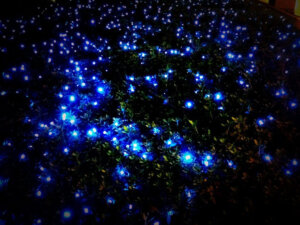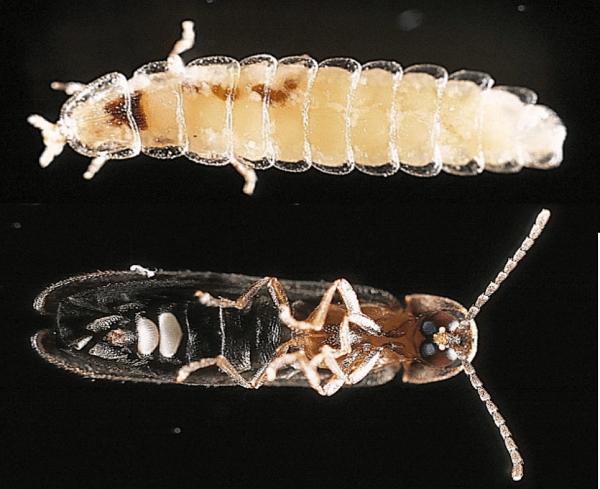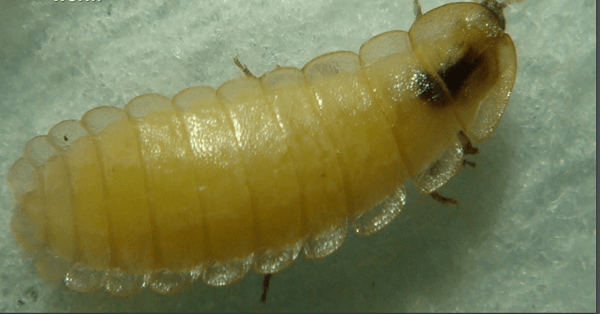Phausis Reticulata, the So-Called "Blue Ghost"


Written and verified by biochemistry Luz Eduviges Thomas-Romero
Phausis reticulata, commonly known as the blue ghost, is a species of firefly found in the eastern and central United States.
Physical traits of the firefly Phausis reticulata
Males of this species are completely brown, have a short second antenna, and large eyes.
Notably, males of most firefly species arent luminescent. However, males of ´the Phausis reticulata species have a fascinating blue glow.
Both sexes are small compared to most other fireflies, growing to about 5-9 millimeters, similar to the size of a grain of rice.
Also, this species exhibits strong sexual dimorphism. Males have normal wings and can fly, while females are neotenic, i.e. they maintain juvenile features. Consequently, females look like in they’re still in the larval stage, with no elytra and wings, and so they can’t fly.
Surprisingly, these flightless females have 4 to 9 point-shaped light organs. The glow they emit is visible dorsally, through the transparent cuticle, and they are known as “glow worms.”

Phausis reticulata mating
Phausis reticulata fireflies’ ideal conditions for the mating season include warm, moist forested areas that are surrounded by fluffy leaf litter. Unlike most other North American fireflies that use flashing for courtship, the light of the Phausis reticulata males lasts for 1 minute at a time.
Thus, males fly by drawing their path with light, just a few feet off the ground. Meanwhile, the flightless females wait, glowing, on the ground. In addition, they have two mating seasons, April-May is the “early season” and June-July is the “late season.”
Geographic distribution
This amazing insect is common in the southern Appalachians, including parts of Georgia, Tennessee, North Carolina, and South Carolina. Commonly, they can be seen in the Great Smoky Mountains National Park, Chattahoochee National Forest, as well as North Carolina’s DuPont State Forest and Pisgah National Forest.
During mating seasons, the landscape becomes ghostly. Thus, the region has become a popular ecotourism destination.
How do fireflies glow?
The short answer is chemistry. The specific chemicals are calcium, adenosine triphosphate (ATP), and something called luciferin. Interestingly, the word “luciferin” comes from the Latin phrase meaning “to bring light”. Also, this word is related to Satan’s alternative name – Lucifer. It’s important to know that luciferin is the essential ingredient in this reaction.
When these three chemicals come together in the presence of oxygen, they glow in a process called bioluminescence, the emission of light by living organisms. The beam can turn the glow on and off by controlling the flow of oxygen to the flashlight.
If you’re wondering whether Phausis reticulata control their flashes, scientists believe these insects may intentionally control their flickering as a means of communication.

Problems facing Phausis reticulata fireflies
Currently, blue ghosts face a number of problems caused by human activity in their habitat.
Light pollution
It’s easy to understand that light pollution from cities and cars increases ambient light, making mating difficult. These insects need a specific environment in order to develop their life cycle.
Phausis reticulata depend on their bioluminescence for mating, so artificial light can seriously affect these processes.
Habitat loss
Moreover, we have the loss of their habitat due to human development. As forests are converted to agricultural fields or housing, valuable habitat is lost. This is a particular problem for Phausis reticulata because of how relatively immobile they are. Indisputably, females depend on a moderately moist undergrowth for survival.
Also, males are similarly bound to a small area because of their weak flight abilities. For these reasons, this species is likely to decline in the face of habitat loss.
Phausis reticulata, commonly known as the blue ghost, is a species of firefly found in the eastern and central United States.
Physical traits of the firefly Phausis reticulata
Males of this species are completely brown, have a short second antenna, and large eyes.
Notably, males of most firefly species arent luminescent. However, males of ´the Phausis reticulata species have a fascinating blue glow.
Both sexes are small compared to most other fireflies, growing to about 5-9 millimeters, similar to the size of a grain of rice.
Also, this species exhibits strong sexual dimorphism. Males have normal wings and can fly, while females are neotenic, i.e. they maintain juvenile features. Consequently, females look like in they’re still in the larval stage, with no elytra and wings, and so they can’t fly.
Surprisingly, these flightless females have 4 to 9 point-shaped light organs. The glow they emit is visible dorsally, through the transparent cuticle, and they are known as “glow worms.”

Phausis reticulata mating
Phausis reticulata fireflies’ ideal conditions for the mating season include warm, moist forested areas that are surrounded by fluffy leaf litter. Unlike most other North American fireflies that use flashing for courtship, the light of the Phausis reticulata males lasts for 1 minute at a time.
Thus, males fly by drawing their path with light, just a few feet off the ground. Meanwhile, the flightless females wait, glowing, on the ground. In addition, they have two mating seasons, April-May is the “early season” and June-July is the “late season.”
Geographic distribution
This amazing insect is common in the southern Appalachians, including parts of Georgia, Tennessee, North Carolina, and South Carolina. Commonly, they can be seen in the Great Smoky Mountains National Park, Chattahoochee National Forest, as well as North Carolina’s DuPont State Forest and Pisgah National Forest.
During mating seasons, the landscape becomes ghostly. Thus, the region has become a popular ecotourism destination.
How do fireflies glow?
The short answer is chemistry. The specific chemicals are calcium, adenosine triphosphate (ATP), and something called luciferin. Interestingly, the word “luciferin” comes from the Latin phrase meaning “to bring light”. Also, this word is related to Satan’s alternative name – Lucifer. It’s important to know that luciferin is the essential ingredient in this reaction.
When these three chemicals come together in the presence of oxygen, they glow in a process called bioluminescence, the emission of light by living organisms. The beam can turn the glow on and off by controlling the flow of oxygen to the flashlight.
If you’re wondering whether Phausis reticulata control their flashes, scientists believe these insects may intentionally control their flickering as a means of communication.

Problems facing Phausis reticulata fireflies
Currently, blue ghosts face a number of problems caused by human activity in their habitat.
Light pollution
It’s easy to understand that light pollution from cities and cars increases ambient light, making mating difficult. These insects need a specific environment in order to develop their life cycle.
Phausis reticulata depend on their bioluminescence for mating, so artificial light can seriously affect these processes.
Habitat loss
Moreover, we have the loss of their habitat due to human development. As forests are converted to agricultural fields or housing, valuable habitat is lost. This is a particular problem for Phausis reticulata because of how relatively immobile they are. Indisputably, females depend on a moderately moist undergrowth for survival.
Also, males are similarly bound to a small area because of their weak flight abilities. For these reasons, this species is likely to decline in the face of habitat loss.
All cited sources were thoroughly reviewed by our team to ensure their quality, reliability, currency, and validity. The bibliography of this article was considered reliable and of academic or scientific accuracy.
- De Cock, R., Faust, L., & Lewis, S. (2014). Courtship and mating in Phausis reticulata (Coleoptera: Lampyridae): male flight behaviors, female glow displays, and male attraction to light traps. Florida Entomologist, 97(4), 1290-1307.
- Frick-Ruppert, Jennifer E, Rosen, Joshua J (2008). Morphology and Behavior of Phausis Reticulata (Blue Ghost Firefly). Journal of the North Carolina Academy of Science. 124.4: 139–47.
This text is provided for informational purposes only and does not replace consultation with a professional. If in doubt, consult your specialist.








